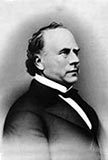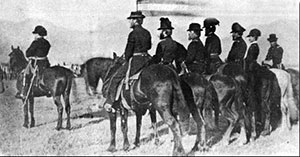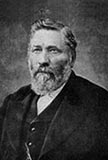Cache Valley Indian Troubles ~ Index
Conditions of the Indian-White relations up until to the Battle of Bear River in 1863.

The first settlers of Cache Valley found the beautiful valley and the mountains surrounding it occupied by Indian camps and one of the chief hunting grounds of the Indians. The Indians lived in different bands but were all known by the general name, Shoshones. It was but natural that these natives should look upon the settlers as trespassing upon their rights on their hunting and fishing grounds by scaring away or taking the game. To revenge themselves, the Indians began to drive away and steal the horses and cattle of the settlers and even resort to murder should the occasion serve. All the Indians, however, did not have this attitude and some became very friendly with the settlers, among which was old Chief Washakie.
Through Cache Valley was one of the main trails for a number of bands of Indians on their migrations north and south according to the season. One of the first and most urgent necessities among the settlers was the adoption of an efficient system of self-defense. With that aptitude and genius for organization among the Mormon people, the settlers immediately organized a military body under the command of Ezra T. Benson as colonel, Thomas E. Ricks as major, in command of a body of "Minute Men" who were expected to be ready for service at any moment, day or night. They were organized in companies, each consisting of five "Tens." Each ten consisted of a second lieutenant, sergeant, nine privates and a teamster with team and wagon for hauling the baggage and provisions for the "Ten." Every man provided himself with necessary arms, ammunition, blankets, provisions and cooking utensils. In addition the Minute Men kept on hand horses, saddles and bridles.

The militia as organized, was frequently drilled by Adjutant William Hyde and James H. Martineau, captain in the corps of the topographical engineers, both of whom had served in the United States Army during the Mexican War. While the militia was always required to be ready for self defense and any emergencies, they were strictly enjoined by President Brigham Young to give the Indians no cause of offense. The settlers were not to kill any game or take the fish which the Indians claimed belonged to them, but to buy what they needed. This would give the Indians food and they would not have to steal from the settlers. President Young always maintained that it was cheaper financially to feed the Indians than to fight them. At the same time, the settlers were to be firm with the Indians and not let them trample on their rights.

July 23rd, 1860, the settlers in Smithfield decided to unite and celebrate the 24th of July and were making preparations for the celebration. Some Indians, with their Chief or leader, "Pahguinup," had stolen a pony at Richmond. They left for Smithfield, at which place the leader "Pahguinup," was arrested and taken to the home of Bishop John G. Smith and held as prisoner. After two or three hours, five young Indians came to the house to rescue their leader. One of the Indians went to the house and told "Pahguinup," to leave with him. As the two were leaving the house, the guards were ordered to fire and "Pahguinup," was shot dead. This precipitated a general fight. The Indians fired and severely wounded Samuel Cousin through the breast. The Indians then started for the brush with the white men following and conducting a running fight. When the Indians arrived near where the east gate of the tabernacle is, they fired on James Read, of Franklin, and Arthur Cowan, who were camped. Read was killed and Cowan was wounded. The Indians then started up the creek toward the hills. They met Ira and Sylaman Merrill who had been for a load of brush. They fired and killed Ira and wounded Sylaman. They attempted to scalp Ira, but Sylaman prevented it by throwing rocks at them. The white men followed the Indians into what is (now) known as Indian Canyon, east of Smithfield. Here the Indians got behind rocks and hid themselves, so the settlers were placed at a great disadvantage.

The Minute Men at Logan were notified of the fight by a messenger from Smithfield. Peter Maughan with George L. Farrell and Thomas E. Ricks and twenty-five minute men, mounted their horses and rode to Smithfield as quickly as possible. They arrived after the skirmish was pretty well over, but they found one Indian hid in the grass and brought him to Logan and placed him under guard in the schoolhouse. Just before dark a band of Indians tried to rush the schoolhouse and free the Indian prisoner, but as there were about one hundred and fifty of the settlers well armed the attack was resisted. The Indians left, but during that summer gave considerable trouble to the settlers. The settlers at Smithfield put all their wagons close together and had guards for night duty so as to give better protection. They constructed a fort along the Summit Creek and during that and the following year, more that sixty-eight log houses were built in fort lines.
About the middle of June 1861, a large body of Indians from Oregon, more than one thousand in number, entered the valley and were determined to clear the country of whites. They encamped on the College Lands along the river bottoms in good positions for defense as well as attack. The value of the military organization became evident and the infantry of each settlement was placed under arms night and morning and were prepared for instant service at any threatened point. Strong guards watched the herds by day and the settlements by night. The minute men were ready for service on a moments notice and a body of fifty picked men, under command of Major Ricks, with George L. Farrell and James H. Martineau as aids, were stationed about a mile from the Indians to act as an observation corps. The Indians also sent out spies to seek weak places for attack but they found none, so they gave up the enterprise and returned to Oregon, but not empty handed. In spite of the vigilance on the part of the settlers, the Indians took away many horses. The following winter, Peadswick, chief of a band of Indians, with a fourth of his principal braves, came to invade Cache Valley, but they perished in a snow slide in a mountain gorge in Idaho.
Sunday, September 28th, 1862, while the people of Logan were at church, word came that a band of Indians from the north had run off a number of horses about two miles from Logan. The meeting was immediately dismissed and a number of volunteers pursued the Indians to recovery the horses. Bear Hunter, an Indian chief then camped at Hyde Park, sent runners ahead to apprise the Indians with the stolen horses of the pursuit. This enabled the Indians to get away with eighteen head of the thirty horses were stolen. The party followed the Indians over the rocks and ravines in the mountains east of Franklin, Idaho. The party over took the Indians on the Cub River but as it was night and very dark, it as not possible to continue the pursuit. It was a cold night with a sleety rain and the men had no bedding but had to lie on the cold, damp ground. They had no food and did not dare make a fire. The next morning the pursuit began, but the Indians had taken to the trail. From this time until the chase was abandoned, horses that had given out were retaken, covered with foam and trembling. A favorite horse belonged to Moses Thatcher, Sr., escaped and was recovered. The pursuit, which began Sunday was continued until Tuesday, when the Indians finding themselves unable to escape in a body scattered in all directions in a dense pine forest. The party had no food so it was decided to give up the chase.
October 1st, 1862, word was received that the Bannock Indians were mustering at Soda Springs, Idaho, for a raid upon Cache Valley. Twenty-five minute men were sent to Franklin to reinforce that place. When the Indians found that the settlers were prepared to receive them, they abandoned the attack. It is well known that Indians will never attack unless circumstances are greatly in their favor and the thorough state of preparation by the settlers prevented a number of conflicts from taking place.
November 23rd, 1862, seventy of the U.S. Calvary from Camp Douglas, Salt Lake City, had a fight with Bear Hunter's band of Indians at the mouth of Providence Canyon, near Providence. The engagement lasted for forty-five minutes, without loss of life on either side. The Indians were stationed among the rocks and cedars and finding that the troops were making ready for the charge, they agreed to give up a white child said to have been taken in a massacre of whites in Oregon. Some of the local settlers had seen the child with the Indians and its face was painted and its dress was similar to that of the Indians, but its light hair and blue eyes betrayed its race. The settlers tried to get the child but the Indians refused to give it up with out ransom and kept it hidden as much as possible. Colonel Patrick E. Conner therefore sent the force of cavalry and secured the child as mentioned.
Before old Chief Bear Hunter would give up the child, it became necessary to bind the chief to a tree and give him so many minutes to make known where the child was or be shot. Bear Hunter was bound to a tree near the first log school and meeting house in Spring Creek, or Providence, near the present tithing office building. The soldiers lined up in front of Bear Hunter and were ready to fire, if he did not reveal the place of the child with a certain time. Before the time expired, Bear Hunter yielded and the child was given over. It was a boy about ten or twelve years of age and the soldiers took him in the log room and put a primer before him to test him out. He still knew his letters and could read simple sentences.
The following day the Indians gathered in force at Providence and began to show hostile demonstrations because the settlers had assisted the cavalry by feeding the troops. Word was sent to Logan and seventy picked men went to Providence to assist. When the Indians saw they were out numbered they sent an interpreter and asked for a consultation. They demanded two beef cattle and a large quantity of flour as a peace offering. Colonel Ezra T. Benson and Peter Maughan considered this the best method, so they acceded to the demands of the Indians. The settlers at Logan furnished the supplies demanded.